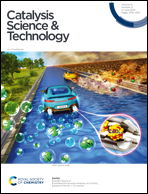Mono- and bimetallic metal catalysts based on Ni and Ru supported on alumina-coated monoliths for CO2 methanation†
Abstract
Structured reactors such as monoliths have some favorable properties over fixed bed reactors such as low pressure drop, ease in handling and fast heat and mass transfer. Some of these properties make them advantageous reactors for the catalytic reduction of CO2 contained in post-combustion gases. Mono- and bimetallic Ru and Ni catalysts on alumina-washcoated cordierite monoliths have been scrutinized for CO2 methanation. The methodology for the preparation of NiRu bimetallic catalysts has been optimized to obtain an outperforming monolithic catalyst. The catalyst providing the highest CH4 productivity corresponds to a bimetallic NiRu catalyst with a small amount of Ru, prepared by consecutive impregnation of Ni and Ru precursors with an intermediate reduction step. This catalyst consists of 2–4 nm Ni nanoparticles interspersed with atomic Ru homogeneously distributed on the alumina coating. This nanostructure endows the catalyst with the highest density of basic sites of medium strength and the highest degree of Ni oxidation in the passivated catalyst compared to the other tested catalysts. The bimetallic monolithic catalyst afforded a stable CO2 methanation activity at high space velocities and with a low pressure drop, reducing energy consumption.



 Please wait while we load your content...
Please wait while we load your content...